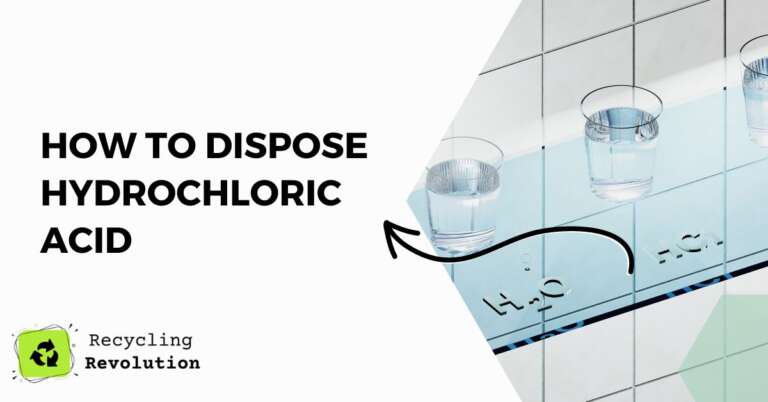You’re cleaning out your garage or laboratory and stumble upon a container of hydrochloric acid. Before you dispose of it, pause and consider the environmental and health consequences of improper disposal. Hazardous substances, like hydrochloric acid, can wreak havoc if not handled with care.
In this article, we’ll dive into the world of hydrochloric acid, a strong, corrosive acid with numerous applications, and guide you through safe disposal methods. Your actions can help protect the environment, yourself, and others from harm.
Overview of Hydrochloric Acid Properties and Common Uses
Hydrochloric acid, also known as muriatic acid, is a colorless, strong, and corrosive acid with a pungent smell. It’s used in various industries for applications like metal cleaning, pH control, and the production of chemicals and polymers.
Improper disposal of hydrochloric acid can have serious consequences. It can contaminate water sources, harm aquatic life, and even cause chemical burns or respiratory issues for humans.
Preparing for Disposal
Gathering Necessary Materials and Equipment
Before disposing of hydrochloric acid, gather appropriate containers, neutralizing agents, and personal protective equipment to ensure a safe and successful process.
Ensuring Personal Safety through Proper Protective Gear
Always wear personal protective equipment such as chemical-resistant gloves, goggles, and a lab coat or apron when handling hydrochloric acid to prevent injuries.
Safe Handling Procedures
Identifying Appropriate Storage Containers
Store hydrochloric acid in a compatible, tightly-sealed container, preferably made of high-density polyethylene (HDPE) or polypropylene (PP) to prevent leaks.
Transferring Hydrochloric Acid Safely
Transfer hydrochloric acid cautiously, using a chemical-resistant funnel or siphon pump to minimize the risk of spills.
Avoiding Spills and Leaks during the Handling Process
Be vigilant and focused while handling hydrochloric acid to avoid spills and leaks, and always have spill containment materials on hand in case of an accident.
Methods used to dispose of Hydrochloric acid
Neutralization Method
Understanding the Concept of Neutralization – Neutralization is a process that involves mixing an acid with a base to create water and salt, reducing the corrosiveness of the acid.
Step-by-Step Guide to Neutralizing Hydrochloric Acid – To neutralize hydrochloric acid, slowly add a base, such as sodium bicarbonate or sodium hydroxide, to the acid while stirring. Continue adding the base until the pH reaches a neutral level (around 7).
Recommended Neutralizing Agents and Their Proper Use – Use sodium bicarbonate (baking soda) or sodium hydroxide (caustic soda) as neutralizing agents. Follow the guidelines provided on the packaging and measure the pH of the solution using pH strips or a pH meter.
Dilution Method
Explanation of Dilution as a Disposal Method – Dilution involves adding large amounts of water to hydrochloric acid to reduce its concentration and corrosive properties.
Guidelines for Diluting Hydrochloric Acid – To dilute hydrochloric acid, add it slowly to a large volume of cold water while stirring. Never add water to acid, as this can cause a violent reaction.
Important Precautions and Safety Measures – Always wear personal protective equipment and work in a well-ventilated area when diluting hydrochloric acid. Monitor the pH of the solution and consult local regulations to determine if the diluted solution can be safely disposed of down the drain.
Chemical Exchange and Recycling Options
Chemical Exchange Programs – There’s an old saying, “One man’s trash is another man’s treasure.” This applies to chemicals too. Chemical exchange programs facilitate the reuse of unused or surplus chemicals, reducing waste and promoting sustainability.
Local Resources and Organizations for Recycling Hydrochloric Acid – Many regions have local resources and organizations that facilitate the recycling or disposal of hazardous chemicals like hydrochloric acid. Always check with your local waste disposal facility or environmental agency for guidance.
Contact Information and Guidelines for Engaging in Chemical Exchange or Recycling – Before engaging in chemical exchange or recycling, ensure you understand the guidelines, including proper packaging and labeling of the chemical. Always provide accurate contact information in case of inquiries or emergencies.
Disposal of Residual Solutions and Waste
Once neutralized or diluted, hydrochloric acid can typically be disposed of down the drain with plenty of water, but always check local regulations first.
Guidance on Handling and Disposing of Waste Materials
All waste materials, such as used neutralizing agents or protective gear, should be disposed of according to local waste disposal regulations. Containers used for hydrochloric acid should be rinsed and recycled or disposed of safely.
Adhering to Local Regulations and Guidelines
Remember, it’s crucial to follow your local regulations and guidelines when disposing of hydrochloric acid and related waste materials. Non-compliance can lead to legal repercussions and environmental harm.
Emergency Preparedness
Always have an emergency plan in place when handling hydrochloric acid. This includes knowing the location of the nearest eyewash station, having spill containment materials readily available, and understanding first aid procedures for chemical exposure.
Necessary Steps to Take in Case of a Hydrochloric Acid-related Incident
In the event of a spill or exposure, follow your emergency plan immediately. Remove contaminated clothing, flush the affected area with water, and seek medical attention as needed.
Contacts for Emergency Response Agencies
Ensure you have contact information for your local emergency response agencies, and don’t hesitate to call them in case of a serious incident.
Conclusion
In this journey through the safe disposal of hydrochloric acid, we’ve explored the importance of responsible handling and disposal methods. Remember, your actions can help protect our environment and public health. As you venture forward, take these lessons to heart. Your commitment to safe practices contributes to the protection of our shared home and the health of our communities.
FAQs
What neutralizes hydrochloric acid?
Bases such as sodium bicarbonate (baking soda) or sodium hydroxide (caustic soda) can effectively neutralize hydrochloric acid, resulting in a less corrosive solution of water and salt.
Can hydrochloric acid be flushed down the drain?
Neutralized or diluted hydrochloric acid can often be flushed down the drain with plenty of water, but always check local regulations before doing so to ensure it’s allowed in your area.
Does water neutralize hydrochloric acid?
No, water doesn’t neutralize hydrochloric acid, but it can dilute it to reduce its concentration and corrosiveness. Remember; always add acid to water, not the other way around, to avoid a violent reaction.

